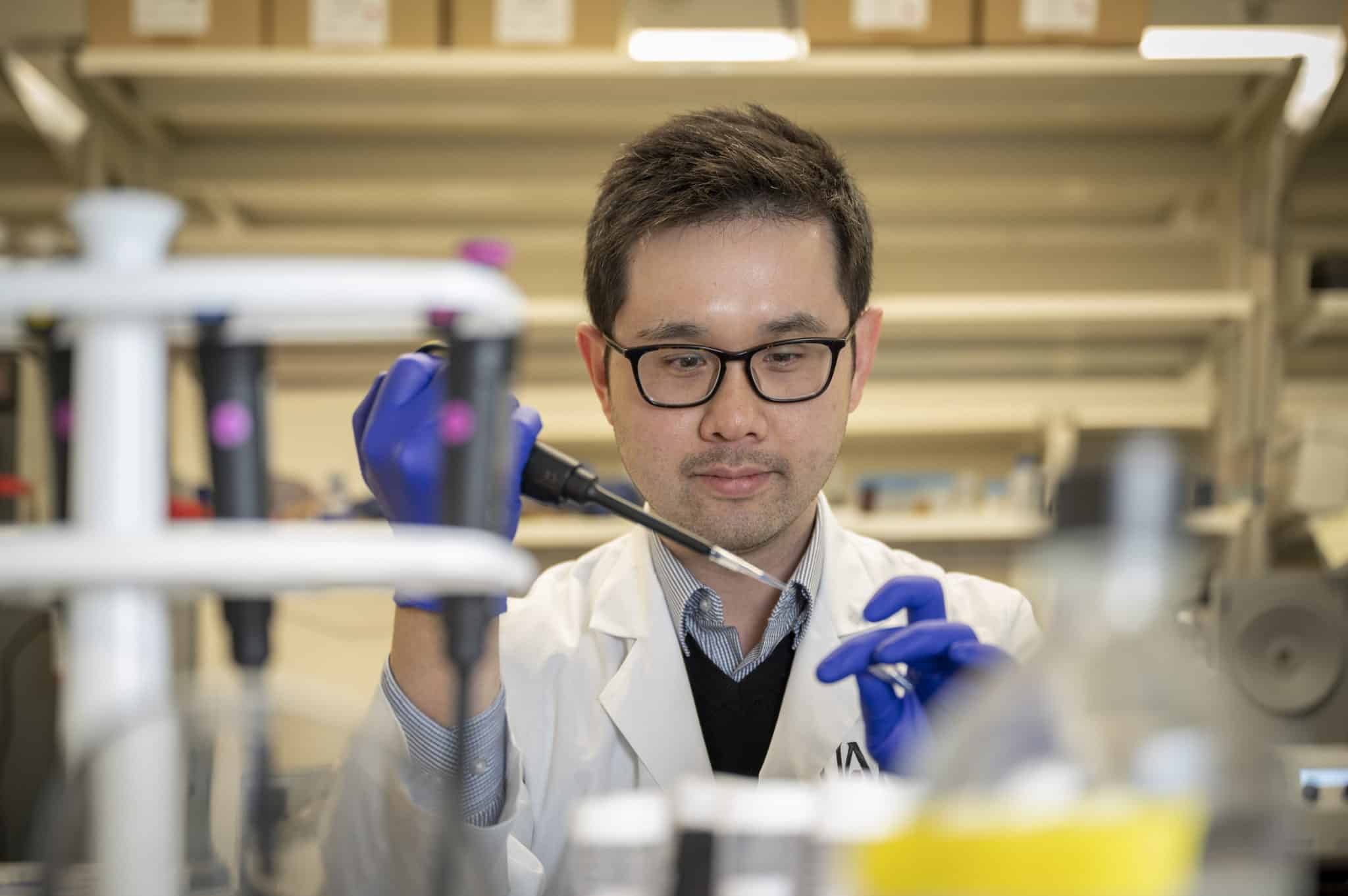View Larger Image

Justin Leung, Ph.D., was recently awarded a $1.9 million federal grant to support his research on DNA damage response in cancer and genetic disorders.
Image by Evan Lewis
$1.9 Million Grant Funds DNA Damage Research by UAMS Scientist Justin Leung, Ph.D.
| A $1.9 million grant from the National Institute of General Medical Studies (NIGMS) will allow a scientist at the University of Arkansas for Medical Sciences (UAMS) to advance his research of DNA damage response (DDR) in cancer and genetic disorders.
Justin Leung, Ph.D., received the five-year grant for his project titled “Deciphering the Chromatin-based DNA Damage Response Pathway.” NIGMS, a part of the National Institutes of Health, supports basic research that improves understanding of biological processes and lays the foundation for advances in disease diagnosis, treatment and prevention.
“DNA damage is a constant threat to our genetic material, so our bodies evolved a surveillance system called the DDR pathway. This pathway maintains our genome integrity by protecting our cells from damage to the genetic information that results in mutations and cell malignancies,” said Leung, assistant professor in the UAMS College of Medicine Department of Radiation Oncology and researcher in the UAMS Winthrop P. Rockefeller Cancer Institute.
An intact DDR pathway and network of DNA-repair proteins are essential for maintaining genome stability. When any component of the DDR pathway is compromised, DNA mutations will accumulate in cells, which potentially lead to diseases including cancer and genetic disorders.
“Our lab aims to understand how cells precisely repair DNA damage at the right place and right time. We investigate how the DDR is initiated and the mechanism by which DNA repair proteins are brought to the DNA breaks,” Leung said.
Leung’s grant, known as an R35 Maximizing Investigators’ Research Award, will be used to build a roadmap of the chromatin-based DDR pathway. The study will potentially provide insight into the causes of cancer and DDR-related genetic diseases. It will also help to develop therapeutic strategies for cancer treatment.
Research Findings Published
Findings from a collaborative project on DNA damage response conducted by Leung and Michael Huen, Ph.D., of the University of Hong Kong, was published July 1 in the scientific journal PNAS (Proceedings of the National Academy of Sciences of the United States of America).
The article titled “Screen identifies DYRK1B network as mediator of transcription repression on damaged chromatin,” outlines the team’s identification of a protein called DYRK1B and its functional network as a new branch of the DNA damage response to protect our genetic materials.
“Our work explains how DYRK1B dysregulation may fuel cancer progression. It also guides the development of a therapeutic strategy for the treatment of cancer and several rare genome instability-associated diseases,” Leung said.
The study uses a comprehensive proteomics approach supported by the IDeA (Institutional Development Award) National Resource for Quantitative Proteomics at UAMS to build an atlas for DYRK1B functions through profiling the potential biological pathways in which DYRK1B is involved.
“This study will open up new avenues for scientific discovery to study not only DNA repair but also a wide range of protein modifications in diverse cellular functions,” Leung said.
Postdoctoral fellow Kirk West, Ph.D., is the UAMS author of the study.
UAMS is the state’s only health sciences university, with colleges of Medicine, Nursing, Pharmacy, Health Professions and Public Health; a graduate school; a hospital; a main campus in Little Rock; a Northwest Arkansas regional campus in Fayetteville; a statewide network of regional campuses; and eight institutes: the Winthrop P. Rockefeller Cancer Institute, Jackson T. Stephens Spine & Neurosciences Institute, Harvey & Bernice Jones Eye Institute, Psychiatric Research Institute, Donald W. Reynolds Institute on Aging, Translational Research Institute, Institute for Digital Health & Innovation and the Institute for Community Health Innovation. UAMS includes UAMS Health, a statewide health system that encompasses all of UAMS’ clinical enterprise. UAMS is the only adult Level 1 trauma center in the state. UAMS has 3,485 students, 915 medical residents and fellows, and seven dental residents. It is the state’s largest public employer with more than 11,000 employees, including 1,200 physicians who provide care to patients at UAMS, its regional campuses, Arkansas Children’s, the VA Medical Center and Baptist Health. Visit www.uams.edu or uamshealth.com. Find us on Facebook, X (formerly Twitter), YouTube or Instagram.###